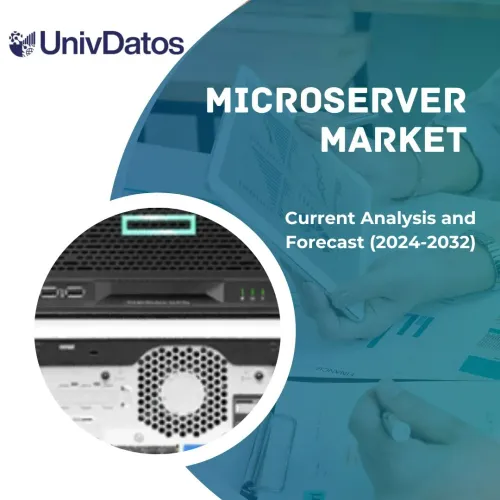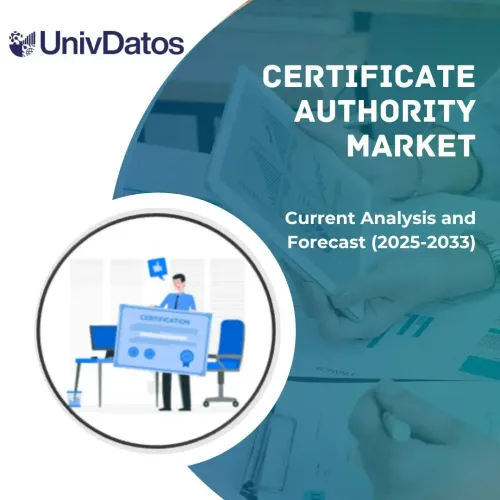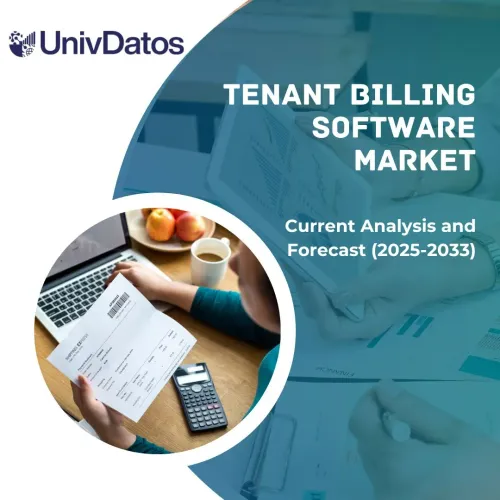- Home
- Chi siamo
- Settore
- Servizi
- Lettura
- Contattaci
Mercato del software Robo-Advisory: analisi attuale e previsioni (2023-2030)
Focus sul modello di business (pure robo advisor e hybrid robo advisor); fornitore (fintech robo advisor, banche, gestori patrimoniali tradizionali e altri); e regione/paese
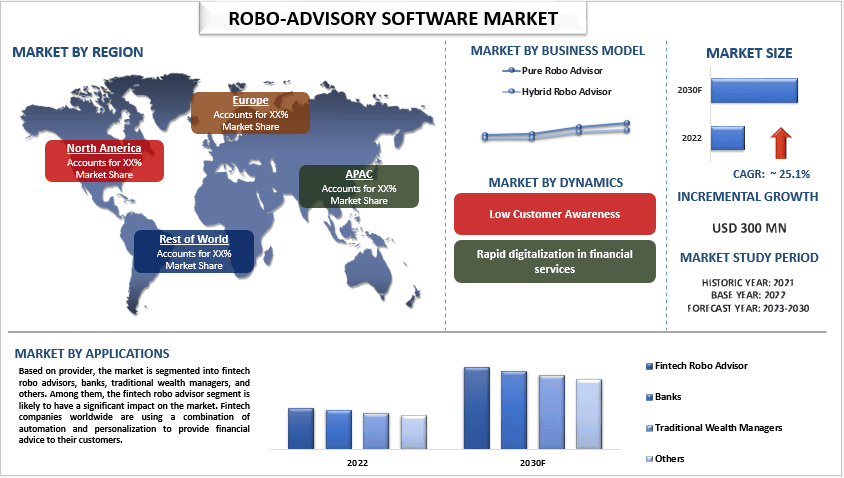
Il mercato del software Robo-Advisory è stato valutato a 300 milioni nel 2022 e si prevede che crescerà a un tasso costante di circa il 25,1% nel periodo previsto (2023-2030) a causa della crescente prevalenza di smartphone e dell'aumento del numero di utenti di Internet in tutto il mondo.Il software Robo-advisory è un tipo di software che fornisce servizi automatizzati di gestione degli investimenti ai clienti. Utilizza algoritmi e machine learning per analizzare i dati di mercato, determinare strategie di investimento ottimali ed eseguire operazioni per conto dei clienti. Questo offre una gamma di servizi, tra cui la gestione del portafoglio, la tax-loss harvesting e il ribilanciamento automatico. Forniscono inoltre l'accesso in tempo reale ai saldi dei conti, alla performance degli investimenti e alle notizie di mercato. I servizi di robo-advisory stanno diventando sempre più popolari tra gli investitori grazie alla loro convenienza e accessibilità. Offrono un modo economico per gli individui di investire fondi, rendendo più accessibile a una più ampia gamma di persone la partecipazione al mercato finanziario. Questo, a sua volta, sta contribuendo alla crescita del mercato del software Robo-Advisory.
Alcuni dei principali attori che operano nel mercato includono Betterment LLC; Wealthfront Corporation; The Vanguard Group, Inc.; Charles Schwab & Co., Inc.; BlackRock, Inc. (FutureAdvisor); Axos Financial, Inc.; SigFig Wealth Management, LLC; Ginmon Vermögensverwaltung GmbH; Ellevest; Social Finance, Inc.
Approfondimenti presentati nel rapporto
“Tra i fornitori, la categoria dei fintech robo advisor assisterà a una crescita significativa del mercato durante il periodo di previsione.”
In base al fornitore, il mercato è segmentato in fintech robo advisor, banche, gestori patrimoniali tradizionali e altri. Tra questi, il segmento fintech robo advisor è probabile che abbia un impatto significativo sul mercato. Le aziende fintech in tutto il mondo stanno utilizzando una combinazione di automazione e personalizzazione per fornire consulenza finanziaria ai propri clienti. Inoltre, stanno implementando rapidamente robo-advisor utilizzando tecnologie avanzate come l'intelligenza artificiale e la finanza quantitativa. Ciò consentirà loro di fornire consulenza sugli investimenti affidabile e accurata agli investitori al dettaglio, aiutandoli a evitare di prendere decisioni di investimento sbagliate.
“Il Nord America deterrà una quota significativa del mercato.”
Si prevede che il Nord America deterrà una quota considerevole del mercato, poiché la regione ha un elevato tasso di adozione dei servizi finanziari digitali, il che ha portato a un gran numero di investitori alla ricerca di soluzioni di investimento automatizzate. Inoltre, la presenza di un gran numero di società di tecnologia finanziaria nella regione ha portato a un alto livello di innovazione nello spazio Robo-Advisory. Inoltre, la regione ha un gran numero di individui ad alto patrimonio netto che sono disposti a investire in soluzioni di investimento automatizzate. Ad esempio, a novembre 2022, JPMorgan Chase ha introdotto un nuovo programma ibrido di robo-advisory chiamato J.P. Morgan Personal Advisors. Questo programma mira a fornire agli investitori una piattaforma digitale per investire e l'accesso a consulenti finanziari umani per una guida continua. Il programma è aperto a tutti gli investitori, ma la società prevede che andrà a beneficio principalmente dei clienti che utilizzano i servizi bancari o di carte di credito di JPMorgan e sono interessati ai servizi di gestione patrimoniale ma non vogliono incontrare consulenti in filiale.
Copertura del rapporto sul mercato del software Robo-Advisory
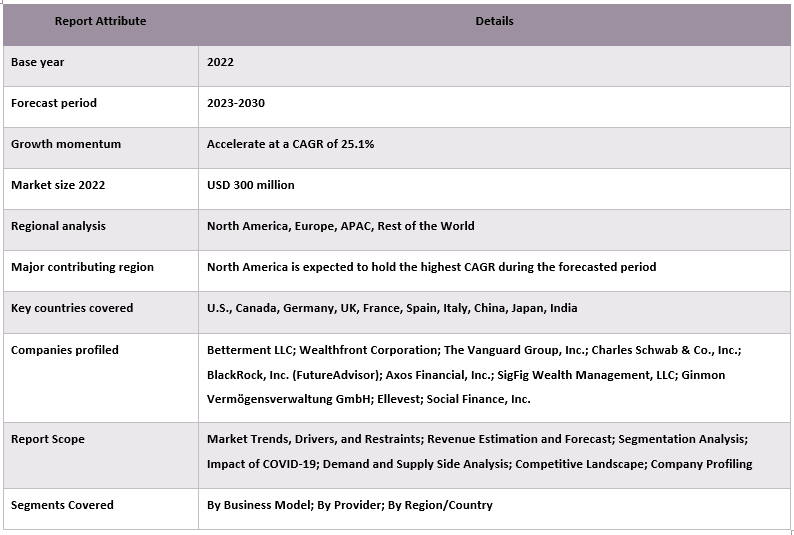
Motivi per acquistare questo rapporto:
- Lo studio include la dimensione del mercato e l'analisi delle previsioni convalidate da esperti chiave del settore autenticati.
- Il rapporto presenta una rapida panoramica delle prestazioni complessive del settore a colpo d'occhio.
- Il rapporto copre un'analisi approfondita dei principali competitor del settore con un focus primario sui principali dati finanziari aziendali, sul portafoglio prodotti, sulle strategie di espansione e sugli sviluppi recenti.
- Esame dettagliato dei driver, dei vincoli, delle tendenze chiave e delle opportunità prevalenti nel settore.
- Lo studio copre in modo completo il mercato in diversi segmenti.
- Analisi approfondita a livello regionale del settore.
Opzioni di personalizzazione:
Il mercato globale del software Robo-advisory può essere ulteriormente personalizzato in base alle esigenze o a qualsiasi altro segmento di mercato. Oltre a ciò, UMI comprende che potresti avere le tue esigenze aziendali, quindi sentiti libero di metterti in contatto con noi per ottenere un rapporto che soddisfi completamente le tue esigenze
Domande frequenti (FAQ)
Indice
Metodologia di ricerca per l'analisi del mercato del software Robo-Advisory
(2023-2030)
L'analisi del mercato storico, la stima del mercato attuale e la previsione del mercato futuro del mercato globale del software Robo-advisory sono stati i tre passaggi principali intrapresi per creare e analizzare l'adozione del software Robo-advisory nelle principali regioni a livello globale. È stata condotta un'esauriente ricerca secondaria per raccogliere i numeri storici del mercato e stimare le dimensioni attuali del mercato. In secondo luogo, per convalidare questi approfondimenti, sono stati presi in considerazione numerosi risultati e ipotesi. Inoltre, sono state condotte anche interviste primarie esaurienti, con esperti del settore lungo tutta la catena del valore del mercato globale del software Robo-advisory. Dopo l'assunzione e la convalida dei numeri di mercato attraverso interviste primarie, abbiamo impiegato un approccio top-down/bottom-up per prevedere le dimensioni complete del mercato. Successivamente, sono stati adottati metodi di suddivisione del mercato e di triangolazione dei dati per stimare e analizzare le dimensioni del mercato dei segmenti e dei sottosegmenti del settore di riferimento. La metodologia dettagliata è spiegata di seguito:
Analisi delle dimensioni storiche del mercato
Fase 1: studio approfondito delle fonti secondarie:
È stato condotto uno studio secondario dettagliato per ottenere le dimensioni storiche del mercato del software Robo-advisory attraverso fonti interne all'azienda comerelazioni annuali e rendiconti finanziari, presentazioni delle prestazioni, comunicati stampa, ecc.e fonti esterne tra cuiriviste, notizie e articoli, pubblicazioni governative, pubblicazioni della concorrenza, rapporti di settore, database di terze parti e altre pubblicazioni credibili.
Fase 2: Segmentazione del mercato:
Dopo aver ottenuto le dimensioni storiche del mercato del software Robo-advisory, abbiamo condotto un'analisi secondaria dettagliata per raccogliere approfondimenti e quote di mercato storici per diversi segmenti e sottosegmenti per le principali regioni. I segmenti principali sono inclusi nel rapporto come modello di business e fornitore. Ulteriori analisi a livello di paese sono state condotte per valutare l'adozione complessiva dei modelli di test in quella regione.
Fase 3: Analisi dei fattori:
Dopo aver acquisito le dimensioni storiche del mercato di diversi segmenti e sottosegmenti, abbiamo condotto un'analisi dettagliataanalisi dei fattoriper stimare le dimensioni attuali del mercato del software Robo-advisory. Inoltre, abbiamo condotto un'analisi dei fattori utilizzando variabili dipendenti e indipendenti come vari modelli di business e fornitori di software Robo-advisory. È stata condotta un'analisi approfondita degli scenari della domanda e dell'offerta, considerando le principali partnership, fusioni e acquisizioni, l'espansione del business e i lanci di prodotti nel settore del mercato del software Robo-advisory in tutto il mondo.
Stima e previsione delle dimensioni attuali del mercato
Dimensionamento attuale del mercato:Sulla base di approfondimenti utili dai 3 passaggi precedenti, siamo giunti alle dimensioni attuali del mercato, ai principali attori nel mercato globale del software Robo-advisory e alle quote di mercato dei segmenti. Tutte le quote percentuali richieste suddivise e le ripartizioni del mercato sono state determinate utilizzando l'approccio secondario sopra menzionato e sono state verificate attraverso interviste primarie.
Stima e previsione:Per la stima e la previsione del mercato, sono stati assegnati pesi a diversi fattori, tra cui driver e tendenze, vincoli e opportunità disponibili per le parti interessate. Dopo aver analizzato questi fattori, sono state applicate tecniche di previsione pertinenti, ovvero l'approccio top-down/bottom-up, per arrivare alla previsione di mercato per il 2030 per diversi segmenti e sottosegmenti nei principali mercati a livello globale. La metodologia di ricerca adottata per stimare le dimensioni del mercato comprende:
- Le dimensioni del mercato del settore, in termini di ricavi (USD) e il tasso di adozione del mercato del software Robo-advisory nei principali mercati a livello nazionale
- Tutte le quote percentuali, le suddivisioni e le ripartizioni dei segmenti e dei sottosegmenti di mercato
- Attori chiave nel mercato globale del software Robo-advisory in termini di prodotti offerti. Inoltre, le strategie di crescita adottate da questi attori per competere nel mercato in rapida crescita
Convalida delle dimensioni e della quota di mercato
Ricerca primaria:Sono state condotte interviste approfondite con i Key Opinion Leader (KOL) inclusi Top Level Executives (CXO/VP, Responsabile Vendite, Responsabile Marketing, Responsabile Operativo, Responsabile Regionale, Responsabile Paese, ecc.) in tutte le principali regioni. I risultati della ricerca primaria sono stati quindi riassunti e sono state eseguite analisi statistiche per dimostrare l'ipotesi dichiarata. Gli input della ricerca primaria sono stati consolidati con i risultati secondari, trasformando così le informazioni in approfondimenti utili.
Suddivisione dei Partecipanti Principali nelle Diverse Regioni
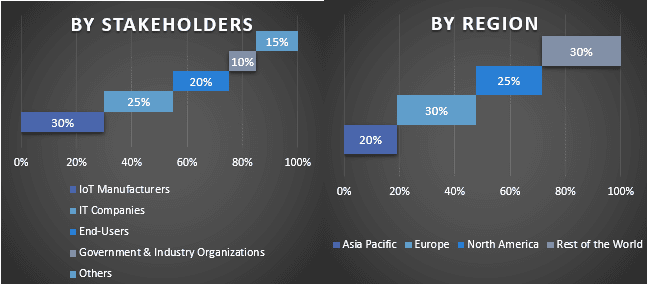
Ingegneria di Mercato
La tecnica di triangolazione dei dati è stata impiegata per completare la stima complessiva del mercato e per ottenere numeri statistici precisi per ogni segmento e sotto-segmento del mercato globale dei software di Robo-advisory. I dati sono stati suddivisi in diversi segmenti e sotto-segmenti dopo aver studiato vari parametri e tendenze nelle aree del modello di business e del fornitore nel mercato globale dei software di Robo-advisory.
L'obiettivo principale dello Studio sul mercato globale dei software di Robo-advisory
Le attuali e future tendenze del mercato globale dei software di Robo-advisory sono state individuate nello studio. Gli investitori possono ottenere informazioni strategiche per basare la loro discrezione per gli investimenti sull'analisi qualitativa e quantitativa eseguita nello studio. Le attuali e future tendenze del mercato hanno determinato l'attrattiva complessiva del mercato a livello regionale, fornendo una piattaforma per il partecipante industriale per sfruttare il mercato inesplorato per beneficiare di un vantaggio del first-mover. Altri obiettivi quantitativi degli studi includono:
- Analizzare le dimensioni attuali e previste del mercato dei software di Robo-advisory in termini di valore (USD). Inoltre, analizzare le dimensioni attuali e previste del mercato dei diversi segmenti e sotto-segmenti
- I segmenti nello studio includono aree di modello di business e fornitore.
- Definizione e analisi del quadro normativo per il settore dei software di Robo-advisory.
- Analizzare la catena del valore coinvolta con la presenza di vari intermediari, insieme all'analisi dei comportamenti dei clienti e dei concorrenti del settore.
- Analizzare le dimensioni attuali e previste del mercato dei software di Robo-advisory per le principali regioni.
- I principali paesi delle regioni studiate nel rapporto includono Asia Pacifico, Europa, Nord America e Resto del mondo.
- Profili aziendali del mercato dei software di Robo-advisory e le strategie di crescita adottate dagli operatori del mercato per sostenersi nel mercato in rapida crescita.
- Analisi approfondita del settore a livello regionale
Domande frequenti FAQ
Q1: Qual è l'attuale dimensione del mercato e il potenziale di crescita del mercato globale del software di consulenza robotizzata?
Q2: Quali sono i fattori trainanti per la crescita del mercato globale del software di consulenza robotizzata?
Q3: Quale segmento detiene la quota maggiore del mercato globale del software di consulenza robotizzata per modello di business?
Q4: Quali sono le tecnologie e le tendenze emergenti nel mercato globale del software di consulenza robotizzata?
Q5: Quale regione dominerà il mercato globale del software di consulenza robotizzata?
Correlati Report
I clienti che hanno acquistato questo articolo hanno acquistato anche



